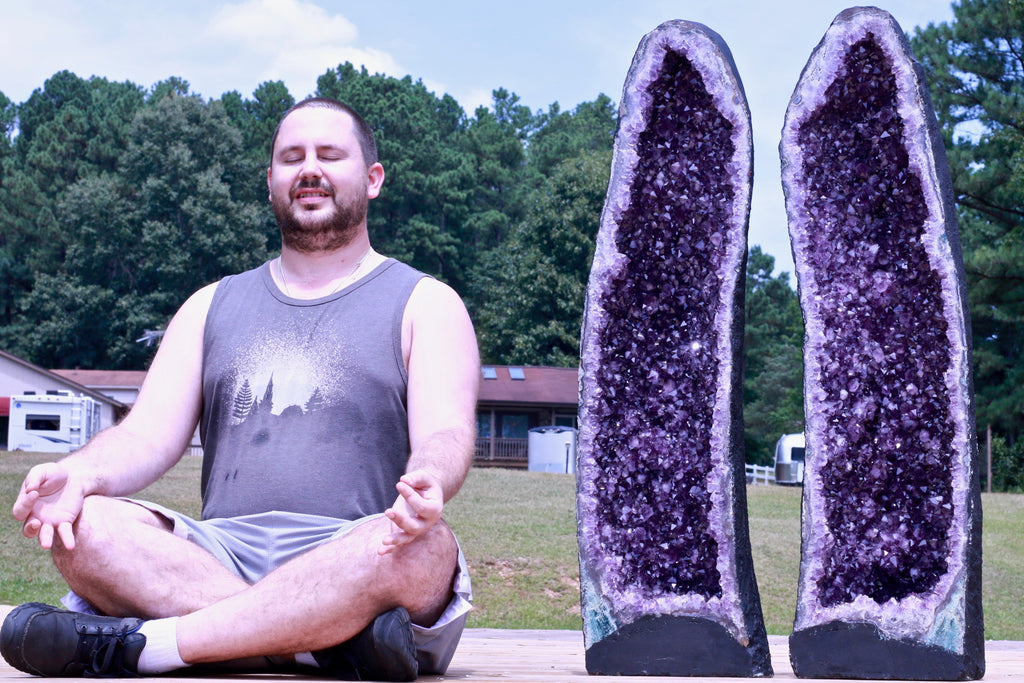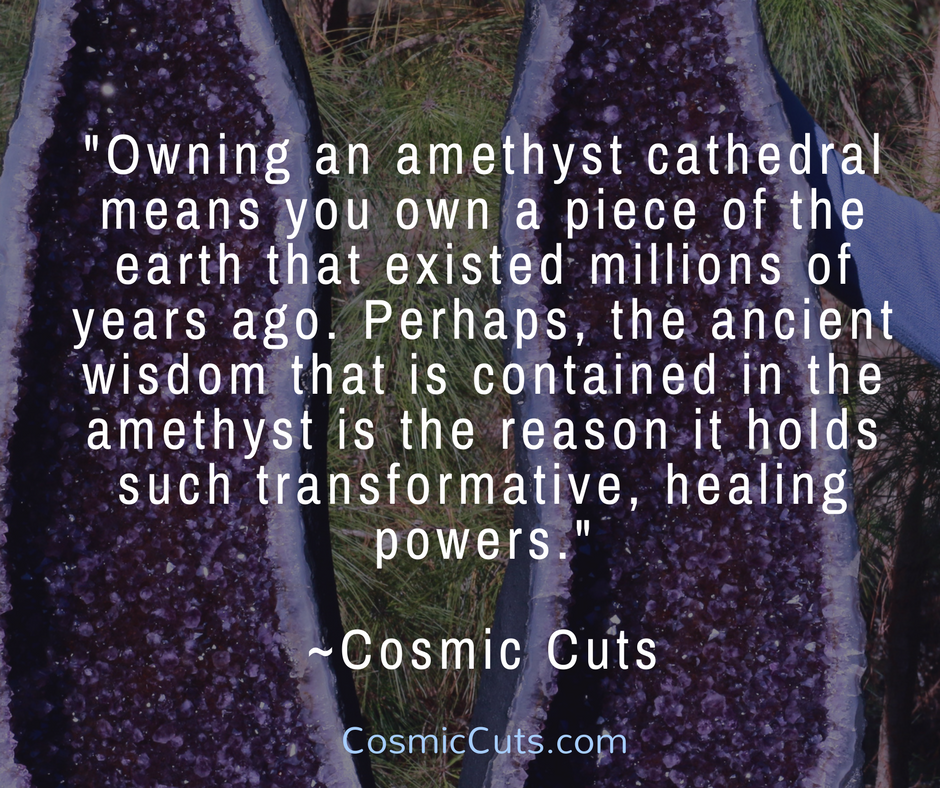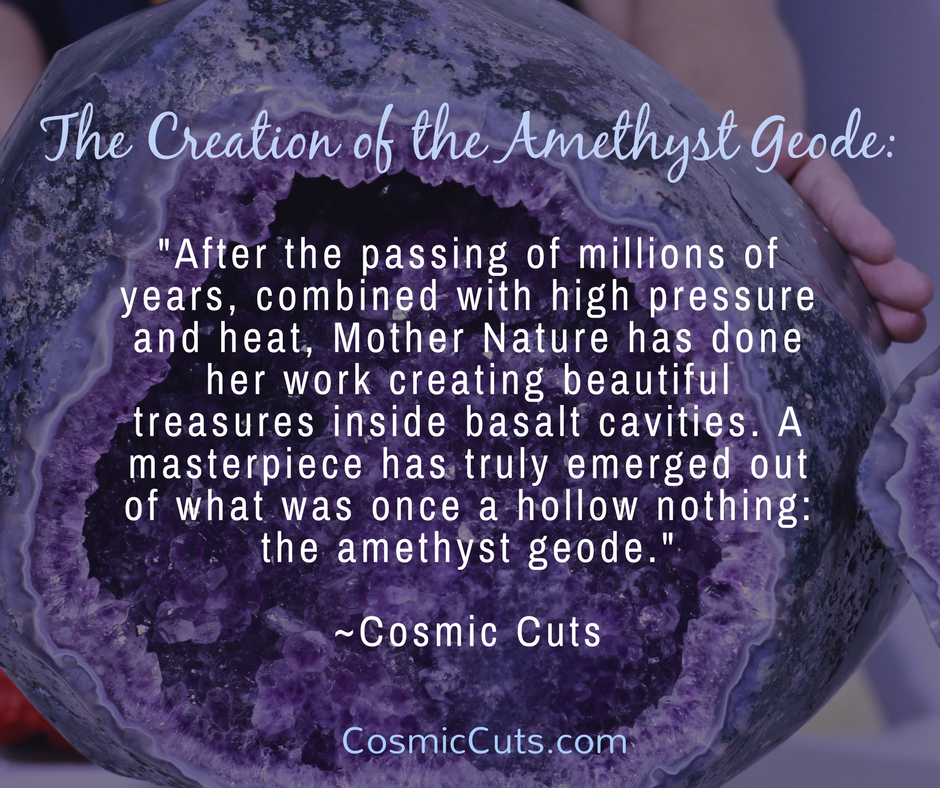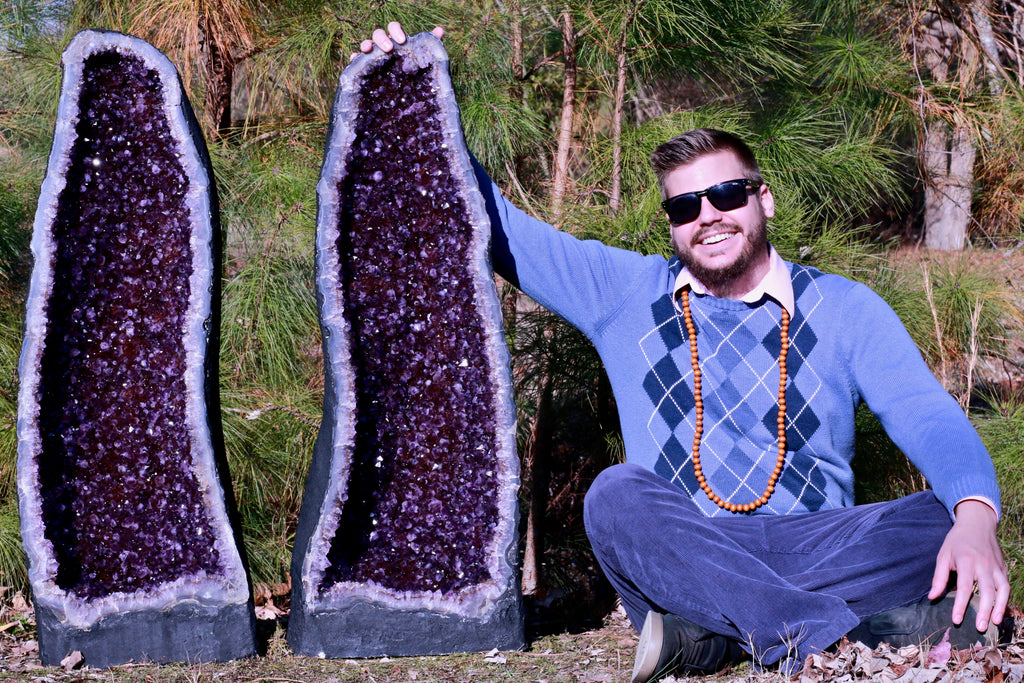
An Astonishing Behind the Scenes Look at the Amethyst Cathedral
INSIDE: Amethyst cathedrals are beautiful, powerful, miraculous, and every one of them is ancient. No one can escape their draw, yet most of us have no idea how they came to be. If amethyst cathedrals have intrigued you, and you've found yourself wondering how they are formed, read on!
Have you ever cracked open a small geode that you bought at a store?
If you have, then you've witnessed how miraculous and fascinating it is to see the wonderous, sparkling beauty that reveals itself from inside such an unassuming, rather boring rock.
Multiply that effect times a thousand, and you might be able to understand what it would feel like to discover an amethyst geode the length of your arm.
Amethyst cathedrals and geodes are beautiful.
They are powerful.
They are miraculous, and every one of them is ancient.
No one can escape their draw, yet most of us have no idea how they came to be.

If amethyst geodes and amethyst cathedrals have intrigued you, and you've found yourself wondering how they are formed, read on!
Where Do Amethyst Cathedrals Comes From?
An amethyst cathedral, otherwise known as an amethyst church, is a geode that is typically tall and thin and shaped like the arch of a cathedral.
Amethyst is a type of quartz that contains a few parts per million of iron, providing its incredible purple color.
While amethyst geodes are found in Mexico, Uruguay, and even the United States, most of the amethyst geodes and amethyst cathedrals that are the most attractive and contain the deepest purple color comes from Rio Grande do Sul, Brazil.
These amethyst geodes from Brazil are mined from lava flows in the Parana Continental Flood Basalt Province, which is one of the most massive basalt lava outpourings that have been discovered to date. According to Show Me Rockhounds, approximately 800,000 cubic kilometers of lava extruded in this area over an 11 million year time span. And that occurred about 130 million years ago!
As you can see, owning an amethyst cathedral means you own a piece of the earth that existed millions of years ago. Perhaps, the ancient wisdom that is contained in the amethyst is the reason it holds such transformative, healing powers. Afterall, the healing benefits of amethyst are quite extensive.

How is an Amethyst Cathedral Formed?
Amethyst cathedrals are partially man-made. However, the beautiful crystal part of the geode forms naturally over many thousands or millions of years before it is even touched by people.
The Natural Formation of Amethyst Geodes
Step 1 - Gas Bubbles Form Cavities in Lava
The first step in the formation of an amethyst geode occurs from the flow of lava. Gas bubbles within the lava rise to the top, just like the bubbles you see when you pour a soda. When the lava cools quickly, the lava thickens, and the bubbles can't reach the top. Those trapped bubbles form hollow cavities as the lava hardens around it.
The size of these bubbles can range from microscopic to fifteen feet long. Typically, they are longer than they are wide, which is where the cathedral name came from - when they are cut in half, each half resembles a church cathedral.
Step 2 - Crystals Form Inside the Cavity
When referring specifically to the lava flows in Brazil, it is thought that water from an aquifer below the lava was at some point forced out and up into the cavities in the lava. Since it was basalt lava and basalt is porous, the water was able to penetrate the hollow cavities.
The water that entered the cavities was salt water that contained inclusions of silica and other minerals from the ground below. Then, cooling and pressure release over many thousands and sometimes millions of years grows the crystals inside the cavity.
The mineral inclusions that are trapped within the geode cavity determines what type of crystals will be inside. In Rio Grande do Sul, Brazil, the minerals trapped in the cavities form layers within the cavities, which typically include celadonite first, then agate, then quartz, and finally amethyst. Sometimes calcite, euhedral crystals, and gypsum inclusions can be found as well.
Other lava flows in other areas will yield different variations of minerals. For example, the amethyst geodes in Uruguay don't contain the celadonite coating.
The Natural Formation of the Layers Inside an Amethyst Cathedral
This example is taken from the lava flows of Rio Grande do Sul, Brazil. Other lava flows in other areas will vary, but the same general concept takes place in the formation of an amethyst geode.
 1) The outer layer of the amethyst geode is basalt, which is what created the cavity that remained empty for millions of years before the crystals grew inside.
1) The outer layer of the amethyst geode is basalt, which is what created the cavity that remained empty for millions of years before the crystals grew inside.
2) The next layer along the inside of the cavity is composed of green celadonite (from the mica mineral group).
3) Agate (a variety of quartz) then formed along the inside of the celadonite.
4) Next, you'll find colorless quartz (silica).
5) Finally, the last layer is amethyst, which is composed of silica and iron.

The Man-Made Process - How the Amethyst Cathedral is Created
After the passing of millions of years, combined with high pressure and heat, Mother Nature has done her work creating beautiful treasures inside basalt cavities. A masterpiece has truly emerged out of what was once a hollow nothing.
Mankind then takes her beauty and preserves it with a man-made process. The process is tedious but absolutely worth it since it is what allows so many of us to benefit from the amethyst's beauty and healing properties.
Step 1 - Mining of the Amethyst Geodes
The process of creating an amethyst cathedral begins with the mining of the geode. Cave tunnels are created in the area of the lava flows, and holes are drilled into the cave walls. A tiny camera is then inserted into the holes so the miners can look behind the wall to hunt for amethyst crystals.
When amethyst crystals are found, the miners use rock chippers, hammers, and chisels to very carefully and precisely break down the wall around the geodes. Special care is taken to ensure the entire geode is removed intact.
Step 2 - The Amethyst Cathedral is Created
To create the shape of the amethyst cathedral, the amethyst geode is cut in half lengthwise with a diamond saw (thick-skinned geodes are typically cut in the opposite direction to create amethyst geode slices).
Cement is added to the outside of the geode and along the bottom where a base is formed, serving to stabilize the geode, cover all reinforced cracks, and thicken its rim.
The amethyst crystals are then sanded and polished to enhance their natural sparkle.
The drill hole is filled up to the base with crushed quartz crystals, and then loose amethyst crystals that are similar to the ones around the hole are placed on top of the crushed quartz. Epoxy resin glue is used to hold it all in place and to reinforce any cracks, which can be natural or as a result of being removed from the cave wall.
Finally, the cement is coated with black paint to form a beautiful backdrop for the sparkling purple amethyst crystals.

What Size is the Largest Amethyst Cathedral in the World?
The world's largest amethyst cathedral is known as the Empress of Uruguay. It is stands at almost eight feet tall and weighs over 5000 pounds.
What Role Does Size Play in the Benefits of an Amethyst Cathedral?
The healing properties of amethyst are vast, which is one of the best reasons to purchase a large amethyst cathedral. But, amethyst cathedral price can be out of many people's budgets when looking at the larger geodes.
Thankfully, amethyst cathedral geodes come in many shapes and sizes. Their value is determined by several characteristics, including overall size, size of the crystal points, and depth of color, to name a few.
Small amethyst cathedrals are available that provide the same benefits as large ones, but with a smaller range. While a large amethyst cathedral geode can fill an entire house with its healing energy, for example, a small amethyst cathedral might only offer its energy to a certain room.
Browse our wide range of amethyst geode sizes here.
How to Determine Amethyst Cathedral Geode Value?
Amethyst cathedrals aren't all created equal, and it's easy to come across an amethyst cathedral for sale that would be a waste of your money.
There are certain characteristics to look for in a large amethyst cathedral geode that can help you make an educated choice and get the most value for the price. We've written an article outlining those characteristics here.
Concluding Thoughts
Amethyst geodes are fascinating in an of themselves, but the entire process of how an amethyst cathedral is created, both by nature and with the help of mankind, is quite intriguing.
Now, when you look at your amethyst cathedral, you can envision the millions of years it spent forming its layers and growing its amethyst crystals safely inside its cocoon.
And you can appreciate the tedious care the miners took to carefully remove and preserve the beautiful butterfly that was allowed to emerge as a result of their work.
Please comment below with the parts of this process that interest you the most. We'd love to engage in a rich conversation about the creation of the fabulous amethyst cathedral.
* Crystals and stones should not be used as a substitute for medical advice or treatment. This article may contain affiliate links. Please read our full disclaimer notice here.



Sources:
https://www.sciencedirect.com/science/article/pii/S0895981109001539?via%3Dihub
https://link.springer.com/article/10.1007/s00126-002-0310-7
https://www.mindat.org/article.php/905/Amethyst+Specimens










1 comment
I really love all the crystals I’ve bought for your business